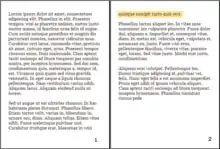Widows and orphans
In typesetting, widows and orphans are lines at the beginning or end of a paragraph which are left dangling at the top or bottom of a page or column, separated from the rest of the paragraph. (The typographer's terms for the top and bottom of a page or column are head and foot.)

At the end of the first paragraph, the word "lorem" is an orphan in the second sense: a very short final line that, because the rest of its line is white, creates an impression of two lines of whitespace between the paragraphs.
Definitions
There is some disagreement about the definitions of widow and orphan; what one source calls a widow another calls an orphan.[1][2][3] The Chicago Manual of Style provides these definitions:[3]
- Widow
- A paragraph-ending line that falls at the beginning of the following page or column, thus separated from the rest of the text. Mnemonically, a widow is "alone at the top" (of the family tree but, in this case, of the page).
- Orphan
- A paragraph-opening line that appears by itself at the bottom of a page or column, thus separated from the rest of the text. Mnemonically, an orphan is "alone at the bottom" (of the family tree but, in this case, of the page).
- Alternately, A word, part of a word, or very short line that appears by itself at the end of a paragraph. Mnemonically still "alone at the bottom", just this time at the bottom of a paragraph. Orphans of this type give the impression of too much white space between paragraphs.
Remembering the terms
A common mnemonic is "An orphan has no past; a widow has no future"[4] or "An orphan is left behind, whereas a widow must go on alone".
Another way to think is that orphaned lines appear at the "birth" (start) of paragraphs; widowed lines appear at the "death" (end) of paragraphs. "An orphan is alone from the beginning; a widow is alone at the end," or "An orphan starts alone, a widow ends alone."
Guidelines
Writing guides, such as the Chicago Manual of Style, generally suggest that a manuscript should have no widows and orphans even if the result of avoiding them is additional space at the bottom of a page or column.[5] However, in its 16th edition (2011) the Chicago Manual of Style suggests a new convention in which pages may end with the first line of a new paragraph.[6]
Some techniques for eliminating widows include:
- Forcing a page break early, producing a shorter page;
- Adjusting the leading, the space between lines of text (although such carding or feathering is usually frowned upon);
- Adjusting the spacing between words to produce "tighter" or "looser" paragraphs;
- Adjusting the hyphenation within the paragraph;
- Adjusting the page's margins;
- Subtle scaling of the page, though too much non-uniform scaling can visibly distort the letters;
- Rewriting a portion of the paragraph;
- Reduce the tracking of the words;
- Adding a pull quote to the text (more common for magazines); and
- Adding a figure to the text, or resizing an existing figure.
An orphan is cured more easily, by inserting a blank line or forcing a page break to push the orphan line onto the next page to be with the rest of its paragraph. Such a cure may have to be undone if editing the text repositions the automatic page or column break.
Similarly, a single orphaned word at the end of a paragraph can be cured by forcing one or more words from the preceding line into the orphan's line. In web-publishing, this is typically accomplished by concatenating the words in question with a non-breaking space and, if available, by utilizing the orphans: and widows: attributes in Cascading Style Sheets. Sometimes it can also be useful to add non-breaking spaces to the first two (or few) short words of a paragraph to avoid that a single orphaned word is placed to the left or right of a picture or table, while the remainder of the text (with longer words) would only appear after the table.
Most full-featured word processors and page layout applications include a paragraph setting (or option) to automatically prevent widows and orphans. When the option is turned on, an orphan is forced to the top of the next page or column; and the line preceding a widow is forced to the next page or column with the last line.
In technical writing where a single source may be published in multiple formats, and now in HTML5 with the expectation of viewing content at different sizes or resolutions, it is recommended to use the word processor settings that automatically prevent widows and orphans. Manual overrides such as inserted empty lines or extra spaces can cause unexpected white space in the middle of pages.
References
- Carter, Rob. A widowed line, highlighted in yellow.
- Day, Ben. Meggs, Philip. Typographic Design: Form and Communication. 2nd ed. John Wiley & Sons: 1993. p. 263.
- Chicago Manual of Style.
- Bringhurst, Robert. The Elements of Typographic Style. 3rd ed. Hartley and Marks Publishers: 2004. pp. 43–44 ISBN 0-88179-206-3
- Chicago Manual of Style, 15th Edition, 3.11 Overall appearance: "A page should not begin with the last line of a paragraph unless it is full measure and should not end with the first line of a new paragraph."
- Chicago Manual of Style, 16th Edition, 2.113: "A page should not begin with the last line of a paragraph unless it is full measure. (A page can, however, end with the first line of a new paragraph.)"